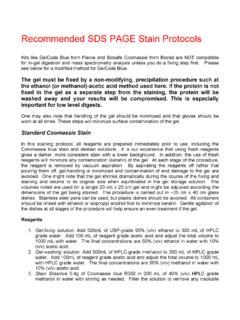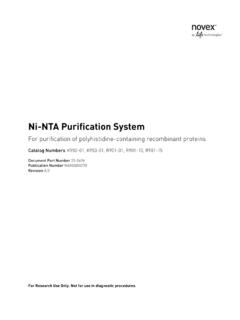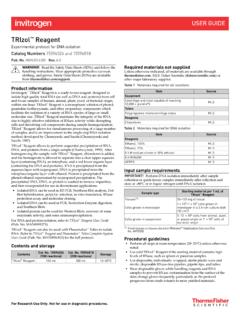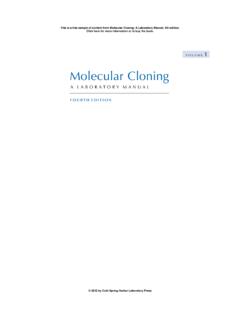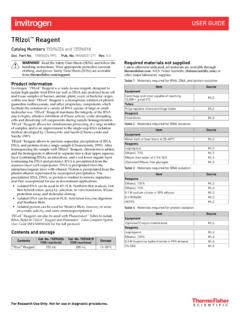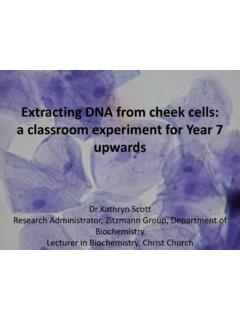Transcription of Ethanol Precipitation of Protein: Protocol and % Recovery
1 Kendrick Labs Inc 800-462-3417 1 Ethanol Precipitation of protein : Protocol and % Recovery Introduction Sodium Dodecyl Sulfate (SDS) is an ionic detergent used in biological buffers to dissolve and denature proteins. Unfortunately, it interferes with many procedures and tests such as immuno- Precipitation and mass spectrometry. Ethanol Precipitation is one method for removing SDS and other alcohol soluble impurities from protein samples with minimal protein loss. This report investigates protein recoveries after Ethanol Precipitation as well as the solubility of SDS in cold 90% Ethanol .
2 In brief, a human osteogenic sarcoma (HOS) cell pellet was prepared in SDS sample buffer. The protein lysate was precipitated with Ethanol as described below and subjected to SDS PAGE with quantitative Coomassie blue staining. The total stain density in lanes loaded with Ethanol -precipitated samples was measured and compared to that of control samples to determine percent protein Recovery . The solubility of SDS in Ethanol was measured by dissolved known amounts in 90% Ethanol , cooling to 80 C, and weighing insoluble solids centrifuged at 15 C.
3 Methods General Ethanol Precipitation Protocol : Add 9 volumes Ethanol to 1 volume of aqueous protein solution. Cool to -80 C for at least 2 hours, then centrifuge for 30 min at >14,000 rpm in a refrigerated centrifuge. If the goal is to remove SDS, for example, if a sample dissolved in SDS buffer has been concentrated by lyophilization, then centrifuge at 15o C. If the goal is to maximize protein Recovery , then centrifuge at 4o C. Pour off the ethanolic supernatant and dissolve the pellet in SDS buffer with vortexing and heating in a boiling water bath.
4 Rinsing the pellet is unnecessary. Adding urea buffer after the pellet is dissolved in SDS buffer or dissolving the pellet in urea buffer only without heating is fine also. In some cases urea improves the 2D gel pattern. However, do not heat samples in the presence of urea or carbamylation will occur. Experimental Sample Preparation: A HOS cell pellet, kindly supplied by Dr. Yair Gazitt, University of Texas, Southwest Medical Center, was lysed in 800 l of osmotic lysis buffer containing nucleases, protease inhibitors, and phosphatase inhibitors by repeatedly pulling through a small bore needle.
5 Three hundred l of SDS boiling buffer without -mercaptoethanol (BME) was added, and the sample was heated in a boiling water bath for five minutes. The protein concentration was determined using the BCA Assay (Smith et. al. Anal. Biochem. 150: 76-85, 1985, and Pierce Chemical Co., Rockford, IL). Three aliquots each of 25 g, 50 g, and 75 g protein were brought up to 20 l in SDS buffer plus BME. protein in three different aliquots each was precipitated by adding Ethanol nine times the volume of the sample, cooling at 80 C overnight, and microcentrifuging for 30 minutes at 14,000 RPM and 15 C.
6 The Ethanol was poured from the pellets, and samples were air-dried before dissolving in 20 l of SDS buffer with BME by heating in a boiling water bath for 5 min. 1D Electrophoresis and quantification: SDS slab gel electrophoresis was carried out for about 4 hrs at 15 mA/gel using a 10% slab gel of dimensions 13 x 15 x cm. The following proteins (Sigma Chemical Co, St. Louis, MO) were used as molecular weight (MW) standards: myosin (220,000), phosphorylase A (94,000), catalase (60,000), actin (43,000), carbonic anhydrase (29,000), and lysozyme (14,000).
7 Each gel was scanned with a laser densitometer (Model PDSI, Molecular Dynamics Inc, Sunnyvale, CA) checked for linearity prior to scanning with a calibrated Neutral Density Filter Set (Melles Griot, Irvine, CA). The images were analyzed using Progenesis Discovery software (version 2005, Nonlinear Dynamics, Durham, NC) by manually circling each lane and subtracting the background (Progenesis mathematical model). SDS Removal During Ethanol Precipitation : Saturating amounts of SDS (40 g, 45 g, and 50 g) were transferred to pre-weighed eppendorf tubes and dissolved in 1 ml of 90% Ethanol .
8 The tubes Kendrick Labs Inc 800-462-3417 2were placed in a 80 C freezer for 2 hours and centrifuged for 30 minutes at 14,000 rpm and 15 C in a refrigerated microcentrifuge (Model Microfuge 22R, Beckman Coulter, Fullerton, CA). The Ethanol was poured off, leaving any insoluble SDS behind. The tubes were allowed to dry completely before re-weighing. Results Over 90% of the whole cell lysate protein was recovered after Ethanol Precipitation as shown in Figure 1 and Table 1. Figure 1. Gel Showing Quantification of Recovered Proteins (p122#1).
9 Lanes 1-3 were loaded with 25 g HOS control sample, while lanes 4-6 were loaded with the redissolved protein pellet from 25 g of Ethanol -precipitated sample. The right-hand lane shows MW standards. The red outlines indicate areas measured for stain density above background. Similar gels were run for 50 and 75 ug Ethanol precipitations. In all 3 gels the patterns before and after Ethanol Precipitation were similar suggesting that the differences are due to small losses of many species rather than large losses of a few proteins. Lane Identification Integrated Density 25 g Original protein Integrated Density 50 g Original protein Integrated Density 75 g Original protein HOS Control (lane 1) 6,011 14,410 20,577 HOS Control (lane 2) 6,991 14,640 20,413 HOS Control (lane 3) 7,091 13,994 21,554 HOS Control Average 6,697 + 597 14,348 + 327 20,848 + 617 HOS EtOH Ppt (lane 4) 6,711 13,711 18,848 HOS EtOH Ppt (lane 5) 6,507 14,085 18,255 HOS EtOH Ppt (lane 6) 6,862 12,542 18,882 HOS EtOH Average 6,693 + 178 13,446 + 805 18,995 + 823 Percent Recovery Table 1.
10 Percent protein Recovery after Ethanol Precipitation . Values for integrated stain density above background are given for 25, 50 and 70 ug protein along with average density, standard deviation, and percent protein Recovery . Kendrick Labs Inc 800-462-3417 3 Table 2 shows that mg SDS is removed per 100 ul of the original protein sample. Thus Ethanol Precipitation is useful for removing SDS from samples. After the protein has precipitated out of the sample, the soluble SDS is poured off the protein pellet with the Ethanol . Tube Original SDS Weight (mg) Final SDS Weight (mg) SDS Removed (mg)

